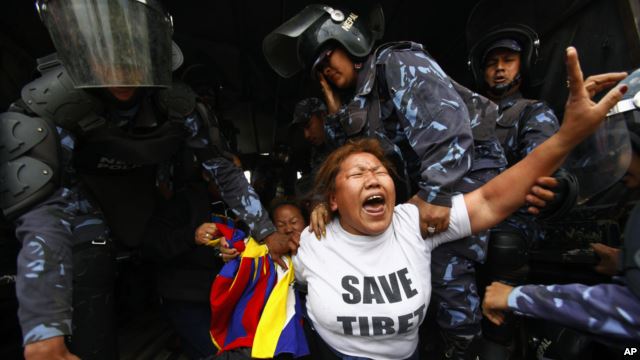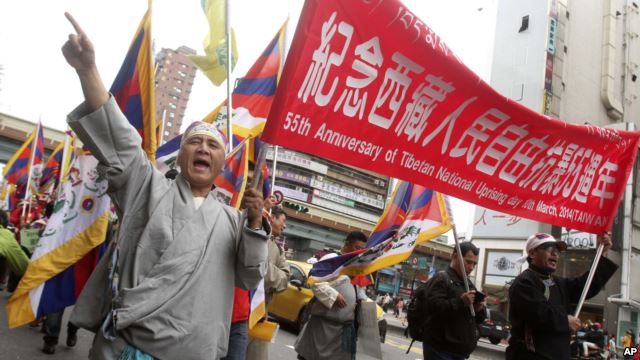Thousands of people around the globe took to the streets on March 10, marking the 55th anniversary of the mass demonstrations across Tibet that led to a violent crackdown by the Chinese government and the exile of the Dalai Lama and the Tibetan government. Now millions of people across the Tibetan plateau are facing forced assimilation under Chinese rule, but their rage and pain is being felt on the other side of the planet.
Tibetan National Uprising Day featured calls for the Chinese government to recognise Tibetan autonomy within its borders, resume dialogue with the Dalai Lama and the Tibetan Government-in-exile, and to address the grievances of the 128 Tibetans who have self-immolated in protest against Chinese rule in recent years.
In New York City, hundreds marched across Brooklyn Bridge to the United Nations headquarters, waving Tibetan flags and shouting pro-Tibet slogans. A member of the Tibetan Youth Congress petitioned the United Nations High Commissioner on Human Rights for more action on the Tibet issue. The rally then moved through Times Square to the Chinese Consulate, where Chinese dissidents, including legal scholar Chen Guangcheng, spoke. “China’s unjust rule in Tibet has led to the killing of a million Tibetans, the destruction of thousands of temples and monasteries, the diluting and destroying of the Tibetan language and culture, and the irreversible damage to the natural environment on the Tibetan plateau,” said Chen. “It has also resulted in the 55 year long exile of His Holiness the Dalai Lama and produced nearly 200,000 Tibetan refugees, condemning them to a state of permanent exile.”
Similar rallies were held in cities across the United States, including San Francisco, Chicago and Salt Lake City.
In the United Kingdom, protesters marched from Downing Street, through central London to the Chinese Embassy, showing solidarity with Tibetans living under Chinese rule, reported Tibet.net. Elsewhere in Europe, Tibet advocates in Belgium marked the occasion by raising Tibetan flags in more than 56 cities around the country.
Many countries, including Canada, France, Germany, Hong Kong, Italy, Japan, Lithuania, Mexico, Portugal, Russia, Swiss, Sweden and Taiwan saw similar rallies in solidarity with Tibet.

Nepalese police detain exile Tibetan as they shout slogans during a protest outside the Chinese embassy visa office on 10th March.
While most protests around the world occurred without incident, at least nine people were arrested in Tibet-related demonstrations around Nepal, according to The Hindu newspaper. Protest areas included Hattisar, the location of the visa section of the Chinese embassy, and Swayambhunath, location of a sizeable Tibetan refugee population. Nepal, which stepped up security measures in the weeks before Tibetan National Uprising Day, does not permit demonstrations designed to anger a “friendly neighbour,” according to The Hindu.
Meanwhile, in Dharamshala, thousands of Tibetans and supporters braved heavy rain to march from Tsuglakhang temple in McLeod Ganj to Kacheri in Lower Dharamshala. They carried Tibetan flags and pictures of the self-immolators, and as they marched raised slogans for freedom in Tibet, the release of the Panchen Lama and for international intervention in the ongoing crisis in Tibet. The march was jointly organised by the four major Tibetan Non Governmental Organisations: the Tibetan Youth Congress; the Tibetan Women’s Association; the Gu-Chu-Sum Movement of Tibet; and Students for a Free Tibet. “The crisis in Tibet has only worsened, which is why Tibetans in exile and Tibet activists around the world are intensifying efforts to urge world governments to build pressure on China to end the severe repression in Tibet,” said the organisers in a joint statement.
For more pictures of the 55th commemoration of the Tibetan Uprising day around the world, please visit:







 Print
Print Email
Email